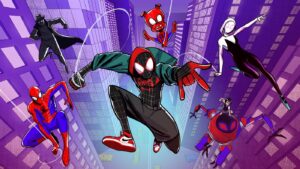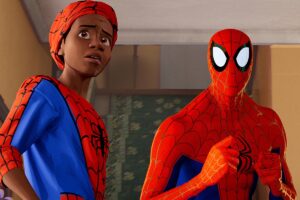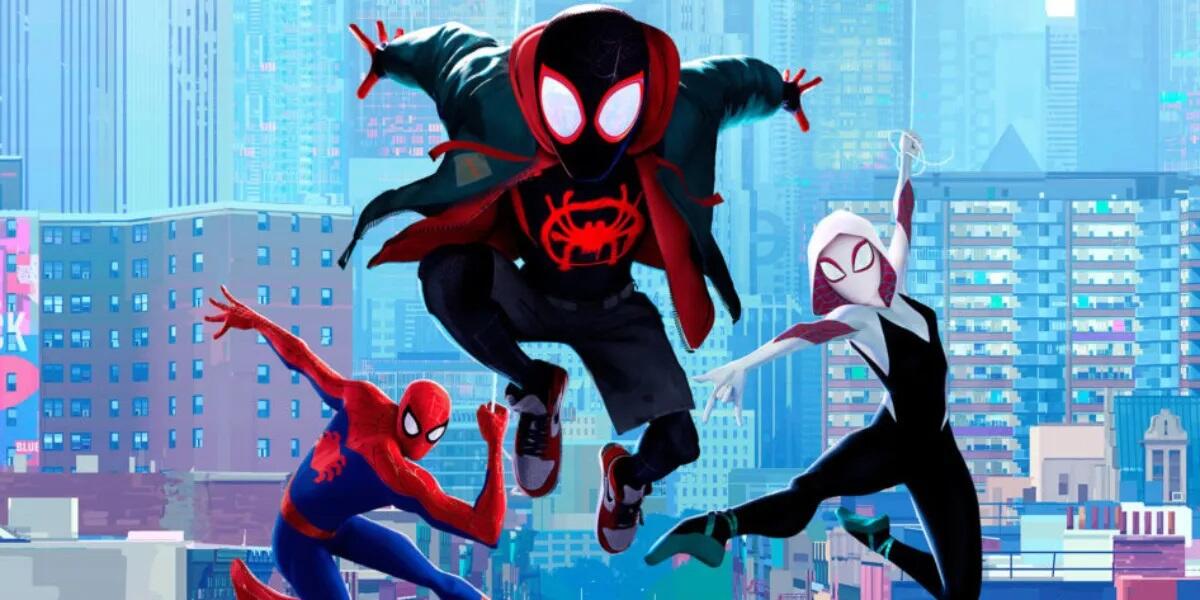
Sony Pictures
INTO THE SPIDER-VERSE
The following Review contains SPOILERS for pretty much all things Spider-Man
Starring Shameik Moore (Miles Morales / Spider-Man), Jake Johnson (Peter B. Parker / Spider-Man), Hailee Steinfeld (Gwen Stacy / Ghost Spider / Spider-Gwen), Mahershala Ali (Aaron Davis / The Prowler), Brian Tyree Henry / Officer Jefferson Davis, Luna Lauren Velez (Rio Morales), Lily Tomlin (May Parker), John Mulaney (Peter Porker / Spider-Ham), Kimiko Glenn (Peni Parker), Nicolas Cage (Peter Parker / Spider-Man Noir), Kathryn Hahn (Doctor Olivia Octavius), Liev Schreiber (Wilson Fisk / The Kingpin), and Chris Pine (Peter Parker / Spider-Man … RIP), with a special appearance by Stan Lee and a post-credits featuring Oscar Isaac as Miguel O’Hara / Spider-Man 2099
Directed by Bob Persichetti, Peter Ramsey, and Rodney Rothman
Produced by Avi Arad, Amy Pascal, Phil Lord, Christopher Miller, and Christina Steinberg
Written by Phil Lord with Rodney Rothman
Music by Danniel Pemberton
Distributed by Sony Pictures Releasing
Run Time: 1 hour and 57 minutes
World Premier: December 1, 2018, in Los Angeles, California
Opening Weekend Box Office: $35 million (North America)
Worldwide Box Office: $384 million
Rotten Tomatoes Score: 97%

Sony Pictures / Marvel Entertainment / The Walt Disney Company
Fun Spider-Verse Facts
Sony Pictures acquired the film and licensing rights to Spider-Man in the Spring of 1999, along with all Marvel characters that had their origins in Spider-Man comic book stories, including Spider-Man’s acclaimed rogue’s gallery. Marvel sold these rights in an effort to stay afloat as they filed for bankruptcy. Under the arrangement, Marvel Studios would assist Sony in a production role that would give them a say in the script-writing process, the hiring of directors, and in casting throughout the production of Sony’s first three Spider-Man films from 2002-2007.
In the meantime, on September 6, 2005, Marvel Enterprises became Marvel Entertainment; a reflection of the company’s new initiative to finance its own motion pictures through Marvel Studios. Two Spider-Man films had been made by Sony and Marvel Entertainment at the time of the announcement: 2002’s Spider-Man and 2004’s Spider-Man 2. A third film (Spider-Man 3) was already in active development at the time of this announcement. Marvel Studios would work in conjunction with Sony on Spider-Man 3, honoring the terms of their initial agreement, and Spider-Man 3 would be released in the Spring of 2007. In the meantime, Kevin Feige (Spring of 2007) would be promoted to President of Marvel Studios and production on Marvel Studios’ first independent film Iron Man would commence just prior to the release of Spider-Man 3.
Beyond Spider-Man 3, the working agreement between Marvel Studios and Sony Pictures as it had once been ceased to exist as the Marvel Studios team concentrated on the creation of the Marvel Cinematic Universe while Sony’s team did their own thing. Former Marvel Studios President and co-founder Avi Arad (who announced his formal resignation from Marvel Studios in the Spring of 2006) remained a part of Sony’s team, and a decision was made to reboot the Spider-Man franchise, culminating in the release of The Amazing Spider-Man (starring Andrew Garfield) in 2012, and a sequel titled The Amazing Spider-Man 2 in 2014.
On February 9, 2015, following a crippling e-mail hack and the critical failure of The Amazing Spider-Man 2, Marvel Studios and Sony Pictures reached an agreement to bring Spider-Man into the Marvel Cinematic Universe, beginning with 2016’s Captain America: Civil War after which Marvel Studios and Sony Pictures would co-produce a new Spider-Man film, which would serve as another reboot. In the Summer of 2015, Tom Holland was cast to portray Peter Parker / Spider-Man within the Marvel Cinematic Universe.
From 2016-2019, Tom Holland appeared as Peter Parker / Spider-Man in 5 Marvel Studios / Sony Pictures projects including Captain America: Civil War, Spider-Man: Homecoming, Avengers: Infinity War, Avengers: Endgame, and Spider-Man: Far From Home. Spider-Man: Far From Home would emerge as the highest-grossing Spider-Man solo film of all-time at the time, bringing in $1.1 billion worldwide.
The five live-action films that featured Spider-Man from 2016-2019 generated more than $7 billion worldwide. If you include 2018’s Into the Spider-Verse, that number crosses the $8 billion mark. This success inspired Sony to begin developing a new live-action Spider-Man Universe, albeit without Spider-Man in it. The first project set in this new Cinematic world was 2018’s Venom starring Tom Hardy. Venom was another financial hit, pulling in $856 million for Sony and the Universe that Tom Hardy’s Eddie Brock / Venom occupied would eventually grow to include Morbius the Living Vampire, portrayed by Jared Leto in the 2022 film Morbius.

Sony Pictures / The Walt Disney Company
On August 21, 2019, Sony Pictures withdrew Spider-Man from the Marvel Cinematic Universe after failing to extend their agreement with Marvel Studios. The two sides ultimately reached a new agreement on September 27, 2019. It was widely believed that as part of the new deal, Sony’s Spider-Man Universe would become part of the MCU as a series of Alternate Realities / Parallel Universes that comprise the greater MCU Multiverse, and that is exactly what happened on October 1, 2021, with the release of Sony Pictures’ Venom: Let There Be Carnage, which saw Tom Hardy’s Eddie Brock / Venom get transported from his home Universe into the MCU 616-Universe. In the meantime, on April 21, 2021, Sony Pictures and The Walt Disney Company (which acquired Marvel Entertainment and Marvel Studios with it 2009) reached a groundbreaking deal to bring all of Sony’s Spider-Man films to the Disney+ streaming service where they would exist alongside other Marvel Cinematic Universe films for viewing by Disney+ subscribers.
In the 2021 Marvel Studios / Sony Pictures co-production Spider-Man: No Way Home, Marvel Studios’ yet-to-be titled Multiverse Saga was kicked into high gear when the events of that film saw Tobey Maguire’s Peter Parker / Spider-Man (from the three Spider-Man films that were released from 2002-2007) and Andrew Garfield’s Peter Parker / Spider-Man (from the 2012-2014 The Amazing Spider-Man films) enter the MCU and share the screen with Tom Holland’s Peter Parker / Spider-Man due to a Multiversal breach triggered by an errant magical spell that was cast by Benedict Cumberbatch’s Doctor Stephen Strange, which involved Tom Holland’s Peter Parker. Within the structure of the Marvel Cinematic Universe, Maguire’s Parker and Garfield’s Parker existed as Multiversal Variants to Holland’s Parker. Along with the two Spider-Men and Eddie Brock / Venom, other characters from Sony’s Spider-Man Universe such as Willem Dafoe’s Green Goblin (Spider-Man), Alfred Molina’s Doctor Octopus (Spider-Man 2), Thomas Haden Church’s Sandman (Spider-Man 3), Rhys Ifans Lizard (The Amazing Spider-Man), and Jamie Fox’s Electro crossed over into the MCU as well. The end of Spider-Man: No Way Home saw the Multiversal Visitors returned to their respective Universes, with each of the villains being cured by the three Spider-Men. Meanwhile, Michael Keaton’s Adrian Toomes / The Vulture (a centerpiece of Spider-Man: Homecoming) was mysteriously transported from the MCU 616-Universe into the same Universe inhabited by Jared Leto’s Mobius and Tom Hardy’s Eddie Brock / Venom. Spider-Man: No Way Home ultimately amassed a triumphant $1.9 billion worldwide, becoming the highest grossing Spider-Man solo film of all-time, the highest grossing film in the history of Sony Pictures, the third-highest grossing Marvel Studios production (behind Avengers: Infinity War and Avengers: Endgame, which both featured Spider-Man), and the highest-grossing film of 2021.
While the concept of the MCU Multiverse was formally established in Marvel Studios’ Loki Disney+ series, the concept of the Spider-Verse was introduced cinematically in 2018, with the release of Sony’s Into the Spider-Verse. The Multiversal breach that brought several Spider-Man characters into the world inhabited by Miles Morales was caused by The Kingpin of Crime through his efforts to use a Particle Accelerator to open portals into other Universes where he hoped to find replacements for the family that he lost. Miles Morales and his team of Multiversal Spider-Beings team-up in an effort to both get the Multiversal Visitors back home and stop The Kingpin from accomplishing his scheme and destroying Miles’ Universe. The widespread critical acclaim generated by Into the Spider-Verse is believed to have inspired Marvel Studios and Sony Pictures’ decision to thoroughly explore the concept of the Multiverse in their next Spider-Verse film, which of course became Spider-Man: No Way Home.
For those keeping score at home, the release of Spider-Man: No Way Home and its canonization of Sony’s Spider-Man Universe also canonizes Into the Spider-Verse, as the voice of actor Cliff Robinson (who portrayed Peter Parker’s Uncle Ben in 2002’s Spider-Man) can be heard during a flashback sequence in the film, and since 2002’s Spider-Man is MCU canon via the Multiverse, so too is Into the Spider-Verse due to its utilization of archived audio from that film.

Sony Pictures
The star of Into the Spider-Verse is of course, Miles Morales / Spider-Man. Miles was created by Brian Michael Bendis and Sara Pichelli for Marvel Comics’ Ultimate Universe, debuting in Ultimate Fallout # 4 in 2011. The Ultimate Universe was launched by Marvel in the year 2000 and was done so in an effort to put a more modern take on their classic characters that could appeal to new readers who might have felt that the notion of 40-years of continuity was too overwhelming. Ultimate Spider-Man was first published in the Fall of 2000 and was an instant hit. The series revolved around Peter Parker and featured a younger Aunt May, a much more monstrous Green Goblin, and a new twist on Peter’s romance with Mary Jane Watson. As the Ultimate Universe expanded, characters such as The X-Men, The Fantastic Four, and The Avengers (The Ultimates) would receive their own titles, and eventually, the Ultimate Universe’s Peter Parker would meet his end at the hands of The Green Goblin, with Miles Morales taking on the mantle of Spider-Man in Parker’s stead. Miles was a huge hit with readers and became a sentimental favorite of fans, as the character really drove home the spirit of Spider-Man as a superhero. Over the course of the ensuing decade, Miles would appear in cartoons and video games, and would even ultimately crossover into Marvel’s main comic book Universe before becoming the fixture of the Into the Spider-Verse film.
Along with Miles Morales, other Spidey characters that are introduced in Into the Spider-Verse as Multiversal Variants include Spider-Gwen (created by Jason Latour and Robbi Rodriguez and making her comic book debut in 2015), Spider-Man Noir (created by David Hine, Fabrice Sapolsky, Carmine di Giandomenico, and Marko Djurdjevic and making his comic book debut in 2009), Peni Parker with SP//dr (created by Gerard Way and making their comic book debut in 2014), and Spider-Ham (created by Larry Hama, Tom DeFalco, and Mark Amstrong with Stan Lee and making his comic book debut in 1983). Into the Spider-Verse is loosely based on the Marvel Comics Spider-Verse Event Series which ran from 2014-2015, written by Dan Slott. That series featured Spider-Gwen, Spider-Man Noir, and Spider-Ham, amongst many other Spider Variants from across the Marvel comic book Multiverse.
Into the Spider-Verse features several cast members that have appeared within the Marvel Cinematic Universe and other Marvel Studios films including Hailee Steinfeld (Kate Bishop in Hawkeye), Mahershala Ali (Blade in Eternals), Brian Tyree Henry (Phastos in Eternals), Nicolas Cage (Johnny Blaze in Ghost Rider), Kathryn Hahn (Agatha Harkness in WandaVision), and of course, Spider-Man co-creator Stan Lee.
The CGI animation for Into the Spider-Verse was combined with what was described as line work and painting and dots and other sorts of comic book techniques to make the visuals look like they were created by hand. This was done in an effort to make viewers feel like they’d walked inside a comic book. Artists would take rendered frames from the CGI animators and work on top of them in 2D, with the goal of making every frame feel like a comic book panel. To make the film feel even more like a comic book, it was animated without motion blur techniques, using instead an older technique of 2D animation called motion smearing.
At the time of its release, Into the Spider-Verse boasted the highest Rotten Tomatoes score of any Marvel film of all time with a 97% Approval Rating. That incredible score has only been topped since by Marvel Studios’ 2022 Disney+ series Ms. Marvel (98%).
Into the Spider-Verse won the Oscar for Best Animated Feature Film at the 91st Academy Awards on February 24, 2019. The Award marked the first time since 2011 that a Walt Disney Pictures production failed to claim the prize.

Sony Pictures
My Into the Spider-Verse Review
Into the Spider-Verse is an animated masterpiece that serves as a love story to Spider-Man, if not to comic books and comic book readers themselves. This is the most uniquely beautiful motion picture that I have ever seen. I have used the phrase “You feel like you’re watching a comic book come to life” to praise a few films that came before it, but Into the Spider-Verse quite truly and literally feels like a comic book come to life! Such care and attention were dedicated to each and every scene and to each and every character! The colors, the movements, the backgrounds, the animation, the thought balloons and word bubbles and action descriptors, all of it comes together to create a living comic book with audible voices and accompanying music! I read and enjoy comic books because the art, the stories, and the characters come together in such a way that I’m taken to another world. Comics make me laugh, they make me cry, and at times, they admittedly make me roll my eyes, but above all else, they entertain me, and they inspire me, and the same exact thing can be said about Into the Spider-Verse, which is why I so very much love this film!
Into the Spider-Verse feels like a film by fans for fans from start to finish and it never apologizes for that in any way. It has a Multiversal plot with Alternate Realities and even a talking pig, yet it assumes that you’re here for it all, including all of the accompanying ridiculousness. You’re not beaten over the head with complicated scientific theories or backstory. Instead, the narrative is perfectly illustrated as are the stakes and the ambitions of the key players, and the story plays itself out from there in a completely easy-to-understand and entertaining way.
This movie is simply about Spider-Man. If you know who and what Spider-Man is, you’re in great shape going in. Radioactive spider. Superpowers. Great Power. Great Responsibility. Blah, blah, blah. From the start, callbacks are made to the classic movies and the comics alike from Uncle Ben’s notorious death to the upside-down kiss in the rain with MJ. The Spider-Man that we first meet is the type of Spider-Man that most of us go to when we think of the character. His name is Peter Parker, he’s young, he’s smart, he’s very heroic, he loves Mary Jane and his Aunt May, and he loves his city and his neighborhood, and he will do anything to protect the innocent from whatever dangers befall them. This Spider-Man resides in the Universe that young Miles Morales calls home. Miles is the son of an African American man and a Hispanic woman, and I only bring the race of the characters up here because Miles existing as a person of color that wears the Spider-Man mask is a beautiful thing and it’s very true to Stan Lee’s original vision for the character: that anyone could look at Spider-Man and imagine themselves under the mask! These days, boys and girls alike of various colors can not only imagine themselves as superheroes, but actually see it represented in live action and animation alike, and I think it’s wonderful! As characters, Miles Morales and Spider-Gwen / Ghost Spider / Spider-Woman embody the heroic tradition of Peter Parker as a character, and I’m a big fan of both of them.
That being said, from the start of this film, we see Miles juggling the responsibilities of school and the complications of family relationships, and all of this really grounds the film in a way that is relatable for most anyone that watches it. It’s clear that Miles is an ordinary boy that is about to have something extraordinary happen to him. Radioactive spider. Superpowers. Great Power. Great Responsibility. You know the drill! There are some twists and turns in this tale however, and the first is the death of Spider-Man. Peter Parker, the Spider-Man of Miles’ Universe is beaten to death by The Kingpin in brutal fashion following a fight with The Green Goblin, and young Miles is left mourning the loss of Spidey while trying to figure out his new powers and abilities.

Sony Pictures
In the meantime, The Kingpin caused a Multiversal breach before he murdered Spider-Man, whom he blames for the deaths of his wife and son, whom he is desperately trying to bring back by plucking a pair of Variants from their home Universe and bringing them into his. Miles finds himself on a mission to prevent The Kingpin from accomplishing this due to the untold dangers of such a thing and he soon finds allies in a group of Spider-Beings from different Timelines, Realities, and Universes.
Spider-Gwen is a version of Gwen Stacy that was bitten by a radioactive spider. Her Peter Parker was her best friend, and he became The Lizard and died fighting her. Spider-Man Noir is from the 1930’s and dresses like a gangster. Spider-Ham is the aforementioned talking pig that was bitten by a radioactive pig. Again, just roll with it, because he’s pretty great! And there’s Peter Benjamin Parker who looks like the Peter Parker from Miles’ Universe, only he’s older with darker hair, a bigger gut, and has fallen into a personal slump after a falling out with his MJ. All of these characters come together to help Miles learn to be the best Spider-Man that he can be and to make a stand against The Kingpin, the female Doc Ock, Tombstone, The Scorpion, and The Prowler.
And The Prowler by the way, is none other than Aaron Davis, Miles’ beloved Uncle! The story of Miles and his Uncle Aaron and how it ties into Miles’ father is beautifully fleshed out. When Miles realizes who The Prowler is, you feel his panic, and when The Prowler is shot by The Kingpin after refusing to kill Miles, you feel his grief! You just know that this is Miles’ “Uncle Ben Moment” and just as we have with the live action versions of Peter Parker in film, we cheer Miles’ fortitude to rise above and take a heroic stand against all odds! The music and animation when Miles takes his “Leap of Faith” is breathtaking, and in the end, Miles gets each member of his Spider-Team back home, beats The Kingpin on his own, and reconciles with his father in a really beautiful moment. it’s a wonderful story!
Honestly, you’ve come to the wrong place if you’re looking for a negative side to this film. For me, there isn’t one! It looks perfect. it sounds perfect. It’s perfectly paced with a perfect mix of fun and heart. It’s a Spider-Man story and quite frankly, it’s one of the greatest Spider-Man stories ever told, and I’ve experienced a lot of them in various formats. I cannot recommend Into the Spider-Verse enough.
If you’ve read this far, you know that this film is MCU adjacent via the Multiverse. That fact was apparently stressed to an even greater extent from what I’ve heard about the sequel (review coming just as soon as I watch the Blu-ray). I think the easiest way to categorize Into the Spider-Verse for it to work narratively as I understand everything is to simply view Miles’ Universe as one of the many worlds that comprise the MCU Multiverse. The MCU 616-Universe is its OWN THING from Iron Man in 2008, to The Marvels this November. The 616-Universe USED TO exist as a controlled Flow of Time overseen by He Who Remains and policed by the Time Variance Authority. There was once a great Multiversal War that pit Universe vs Universe and Variants of He Who Remains (Kang) against each other. He Who Remains ended that Multiversal War and isolated a series of timelines, whose Flow of Time would not lead to the birth of any kind of the warring Variants of Himself, the likes of which He previously conquered. Those Universes comprised his Sacred Timeline and He Who Remains and the TVA saw to it that no Branched Timelines arose from off the Sacred Timeline. However, the Second Season of Loki saw the Temporal Loom that kept the Sacred Timeline functional get destroyed and that, combined with the death of He Who Remains exposed the Sacred Timeline, and it, and all of its Branches were reshaped by a Variant of the Asgardian God of Mischief Loki, who in doing so, at long last found his Glorious Purpose and ascended to Godhood. The 616-Universe was now allowed to Brach as it would with the TVA (who once policed the Sacred Timeline) now existing to hunt and prune Variants of He Who Remains across the Multiverse. So, the way that I see it, the MCU 616-Universe can now crossover with other Universes due to the death of He Who Remains and Into the Spider-Verse (like the aforementioned live action Spider-Man films) occurs in some of these other Universes that comprise the vast MCU Multiverse.

Sony Pictures
Highlights of Into the Spider-Verse:
Miles Morales
Spider-Gwen
Badass Aunt May
Davis-Morales Family Dynamic
Heart
Humor
The Stuck to the Hair Sequence
Music
Animation and Illustration
The Death of Peter Parker

Sony Pictures
Notable MCU Concepts and Characters Introduced:
Into the Spider-Verse serves as an origin story for a subsection of a Universe of characters that were formally introduced into the Marvel Cinematic Universe in 2021’s Spider-Man: No Way Home, such as Tobey Maguire’s Peter Parker / Spider-Man, who is directly referenced in the Into the Spider-Verse film through archived audio of Peter’s Uncle Ben from 2002’s Spider-Man. The possibility of animated worlds existing within the MCU Multiverse was furthermore confirmed in 2022’s Marvel Studios film Doctor Strange in the Multiverse of Madness when Benedict Cumberbatch’s Doctor Steven Strange and Xochitl Gome’s America Chavez briefly inhabit one and transform into animated entities during the sequence in which they tumbled through the Multiverse en route to Earth-838.


Leave a Reply